Back in October, HP announced a refresh for its smaller Spectre x360 PCs, which is typically just the 13.3-inch model. But for the first time, the company introduced the Spectre x360 14. Now, you might be thinking that the '14' indicates that it has a 14-inch display. It doesn't; rather, it indicates that '13' is already taken, as this PC actually has a 13.5-inch screen.
It's not just any 13.5-inch screen though. It's got a 3:2 aspect ratio, something popularized by Microsoft's Surface PCs. In fact, taller screens are becoming more and more common throughout the industry. HP also has an OLED option, a first for a 13.5-inch screen.
Of course, that's not all that's new here. It has Intel's 11th-generation processors with Iris Xe graphics, Thunderbolt 4, and more.
Specs
| CPU | Intel Core i7-1165G7 (up to 4.7 GHz, 12 MB L3 cache, 4 cores) |
|---|---|
| GPU | Intel Iris Xe graphics |
| Display | 13.5" diagonal, WUXGA+ (1920 x 1280), Touch, IPS, edge-to-edge glass, micro-edge, 400 nits |
| Body | 11.75x8.67x0.67in, 2.95lb |
| RAM | 16GB |
| Storage | 512 GB PCIe NVMe M.2 SSD |
| Ports | (2) Thunderbolt 4 (1) USB 3.2 Gen 1 Type-A (1) 3.5mm audio |
| Battery | 4-cell, 66 Wh Li-ion polymer |
| Input | Full-size island-style backlit keyboard, Precision Touchpad Support |
| Webcam | HP True Vision 720p HD IR camera with camera shutter and integrated dual array digital microphones |
| Connectivity | Intel Wi-Fi 6 AX 201 (2x2) and Bluetooth 5 combo |
| Audio | Audio by Bang & Olufsen; Quad speakers; HP Audio Boost |
| Material | Aluminum |
| Color | Poseidon Blue |
| Price | $1,589.99 |
Day one
Design
I've said this many times before, but HP's Spectre x360 series is the sexiest line of PCs on the market. Honestly, these are great laptops, but the design is absolutely a differentiator. This is the type of PC that if you use it in public, people are going to notice it. It's a long way away from the boring old MacBook clones that we still see a lot of, and it's really impressive how it's evolved over the years.

The color of the model that HP sent me is called Poseidon Blue and it has Pale Bronze accents. This is actually the first time that the company has sent me a Poseidon Blue Spectre, which is pretty cool. It also comes in Nightfall Black with Copper Luxe accents, and that one is also stunning. And finally, there's boring old Natural Silver, a color that HP actually killed off one year and then brought back due to popular demand.
The Pale Bronze accents actually look silver, so it's very pale. You'll notice the chrome-colored HP logo stamped in the lid. You can also see the Pale Bronze hinges in the image above; what you can't really see is that the sides are also this color, along with other parts.

It also has gem-cut edges, adding to the style that you find in the Spectre x360. Note that this design is the same as we saw with the last couple of generations of the Spectre x360 14, just adapted for the larger form factor.
You'll notice on the right side that there's a microSD slot, a 3.5mm audio jack, and one USB Type-C port. That USB Type-C port is Thunderbolt 4, which frankly, isn't all that different from Thunderbolt 3. They both support 40Gbps data transfer speeds, or up to two 4K monitors on a single port. The difference is that Thunderbolt 3 had a minimum spec that used two lanes instead of four, supporting half of that, and there was no easy way to know what you were buying. HP always supported the full spec, so nothing is really changing here. That's a good thing, by the way.

Tucked in the corner there is a second Thunderbolt 4 port. The cool thing about that one is that it's designed to keep the cable out of your way, and you can fold the display back without the cable getting in your way as well.

On the left side, there's a USB 3.2 Gen 1 Type-A port, which gets speeds of 5Gbps. If you're unfamiliar with USB 3.2 Gen 1, you might know it better as USB 3.1 Gen 1, or USB 3.0, because they're exactly the same and it just keeps getting rebranded. I'd like to have seen USB 3.2 Gen 2 (or USB 3.1 Gen 2) on here. After all, this is a premium laptop and other PCs are getting it, so I'm not sure why we're getting last-gen ports.
Also, notice that while one of the back corners has a USB Type-C port, the other corner is empty. In previous designs, there was a power button here, but this has been moved to the keyboard.
But most importantly, this convertible laptop is sexy. When it comes down to a laptop that I want to carry with me, the Spectre x360 is it, and a big part of that is because of the design.
Display and audio
Like I said earlier, the Spectre x360 14 has a 13.5-inch 3:2 display. If you don't like taller displays, don't worry because the Spectre x360 13 was refreshed alongside this. You can still get a 13.3-inch 16:9 screen if that's what you want. Keep in mind though that this isn't just 0.2 inches larger. Screens are measured diagonally, so the change in aspect ratio means that it's actually a much bigger display, and it's 25.6mm taller.

This is also a better aspect ratio for portrait orientation. The wider screen is great for a laptop use case, but this is a convertible. This is meant to be used as a tablet just as much as a PC. Now, it feels more natural that way.
There's also an app pre-installed called HP Display Control, which has different settings for the display. This something that the company started using when it introduced OLED displays on its Spectre lineup, because while OLED produces vibrant, beautiful colors, they're not necessarily accurate. HP's display calibration software solved that issue, and now it's available for all screens.

The viewing angle is a full 178 degrees, meaning that you can look at it from any angle without any visible distortion. Also, it's worth noting that this display does come in a 4K OLED variant. While we're starting to see more and more 3:2 laptops hit the market, this is the only one I've seen with an OLED option. I believe that HP did send OLED to some reviewers, but not this one. The company did say it was working on getting me one a few weeks ago, but frankly, I couldn't hold back this review any longer.
Also, there's a 1,000-nit Sure View Reflect option. That's HP's privacy screen technology which is designed to prevent people from looking over your shoulder and being able to see what's on your screen.

Once again, HP partnered up with Bang & Olufsen for the speakers, of which where are four. There's a speaker bar right above the keyboard, something that actually went away on the 13.3-inch model thanks to the footprint shrinking so much. But thanks to the taller display on the 13.5-inch version, it's almost like HP can just use the old chassis.

There are also speakers underneath the device. That way no matter what orientation you're using the Spectre x360 in, you have sound firing at you.
The speakers are loud and they're clear, creating a pretty solid media consumption experience. Whether you're listening to music at your desk or you're playing a game, this gets the job done.
Keyboard and trackpad
The keyboard spans edge to edge on the deck, and it's the same as it is on the 16:9 one. Like I said, the key difference is that it once again has the speakers above it. This keyboard has grown into being one of my favorites for a consumer PC. HP had originally produced what I believe to be the best keyboard on a laptop in its EliteBook 1000 series, but now it's bringing it to more devices.

The keys don't feel wobbly at all, and they seem to have the perfect amount of resistance to be comfortable. It's also a particularly quiet keyboard, something that's really nice if you're like me and tend to hit the keys too hard at times.
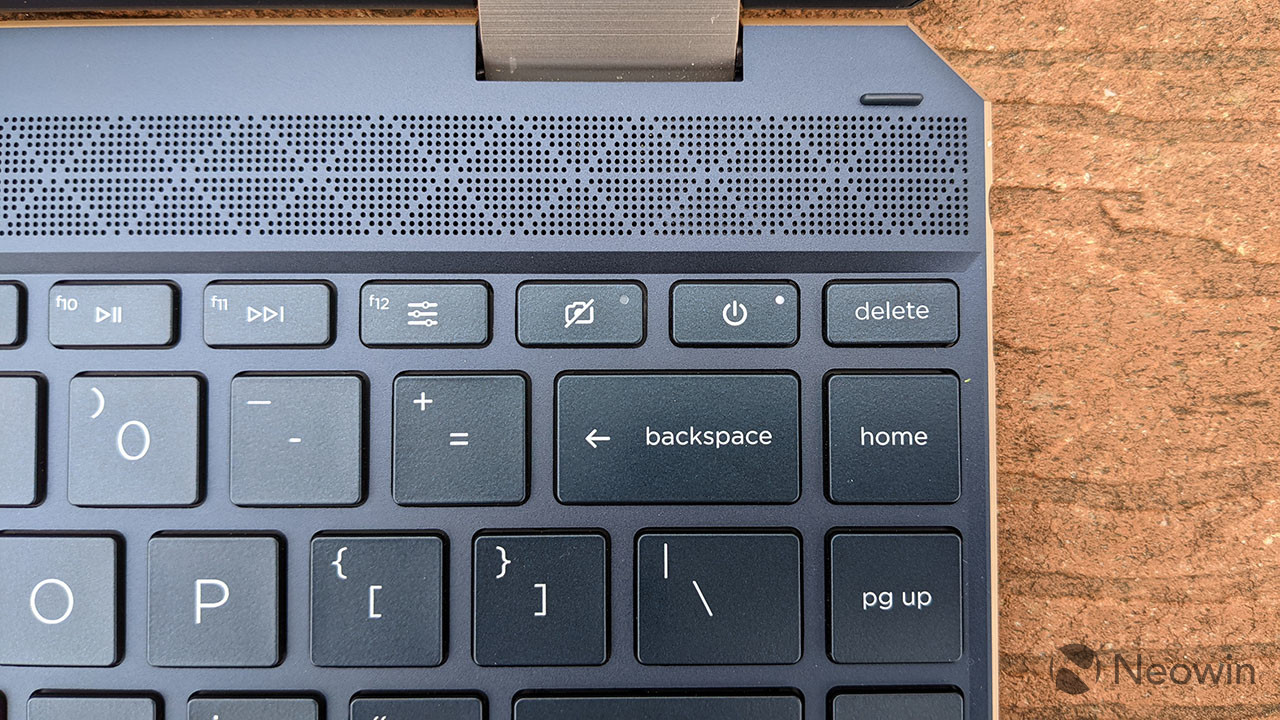
HP also moved a lot of other parts to the keyboard. There's no switch on the side of the chassis for a physical camera shutter anymore, and like I said above, there's no power button on the corner anymore. The way the camera shutter works has changed too. Previously, HP disconnected it internally, an elegant solution that probably wasn't convincing enough for a feature that's designed out of distrust. Now, it disconnects it internally, but it also shows a physical block over the camera.

The fingerprint sensor is part of the keyboard now too. Previously, it was to the bottom-right of the keyboard. Adding these keys to the keyboard is a design change that we're seeing across HP's lineup.

The touchpad is a Microsoft Precision touchpad, something that HP took longer than its competitors to adopt. That means that it's faster, it's more responsive, and it supports the gestures that you're used to.
Performance and battery life
The Spectre x360 14 that HP sent me includes an Intel Core i7-1165G7 and 16GB RAM. The CPU is a quad-core chip with eight threads from the Tiger Lake family. Tiger Lake is Intel's second-generation 10nm family, the first of which was Ice Lake, so the process has been refined a bit.
But also, it includes new Iris Xe graphics. Last year's Ice Lake chips began a focus from Intel on its integrated graphics, so that's being taken to a new level now. Yes, you can play FHD games on this machine, and it's pretty impressive. I'm doing things on thin and light PCs that I'd previously never have done without dedicated graphics.

And if you do need dedicated graphics, you can use Thunderbolt 4 to plug in an external GPU. That's a major benefit of Thunderbolt, which is more or less exclusive to Intel PCs. You can take this on the go and have the power of Iris Xe graphics, and bring it home to a desktop setup that has two 4K monitors and an external GPU, all running off of the two Thunderbolt 4 ports.
For battery life, that's impressive as well. Doing regular work, I got at least eight hours out of it, although I wasn't able to stretch it to 10 hours. This is with the power slider one notch above battery saver and the display brightness at 50%. Of course, this is the FHD model, so that number will suffer if you get the UHD OLED model or the 1,000-nit Sure View configuration. One thing that I can say about HP is that it absolutely cares about battery life in its products, and it rarely lets me down. This is definitely among the best battery life in its class.
For benchmarks, I used PCMark 8, PCMark 10, and Geekbench 5.
| Spectre x360 14 Core i7-1165G7 |
Spectre x360 13 Core i7-1065G7 |
Dell XPS 13 2-in-1 Core i7-1165G7 |
Acer Aspire 7 Ryzen 7 4700U |
|
|---|---|---|---|---|
| PCMark 8: Home | 4,094 | 3,243 | 4,344 | 3,702 |
| PCMark 8: Creative | 4,527 | 3,818 | 4.560 | 4,228 |
| PCMark 8: Work | 3,896 | 3,034 | 3.980 | 3,689 |
| PCMark 10 | 4,705 | 4,147 | 4,929 | 4,718 |
| Geekbench 5 | 1,414 / 4,470 | 1,526 / 5,623 |
Conclusion
HP's Spectre x360 is my favorite family of PCs, just because they're so unique and sexy. Now that the smaller model comes with a 3:2 display, I'll tell you what I really want. I want HP to do this with the larger 15-inch model. Give me something with a 45W CPU and dedicated graphics with a bigger 3:2 display, but I digress.

My only complaints are that it's using a last-gen USB Type-A port, and also that there's no cellular option. HP did announce the Spectre x360 5G at the same time that it announced this, but that's still using the 16:9 display. If you want 3:2, there's no cellular option for the first time in years.
But this is an awesome PC, even aside from the design that I can hardly get over. I'm happy to see the speakers return to the keyboard deck, and speaking of the keyboard, this is probably my new favorite on a consumer laptop. It's phenomenal.
Everything about the Spectre x360 14 is phenomenal, and as always, I totally recommend it. You can find it on Hp.com here.
_full.jpg)




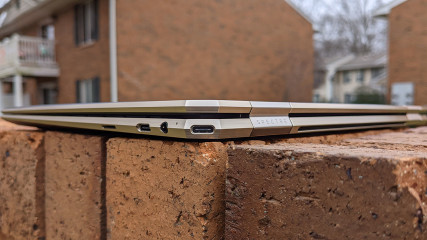




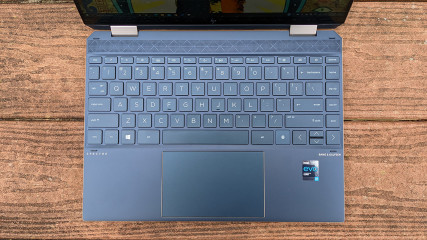


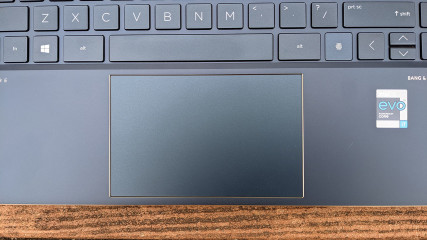


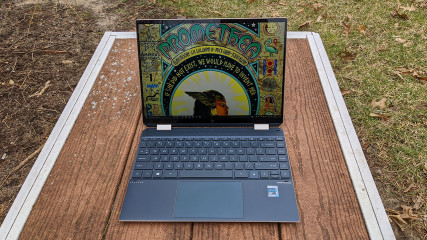
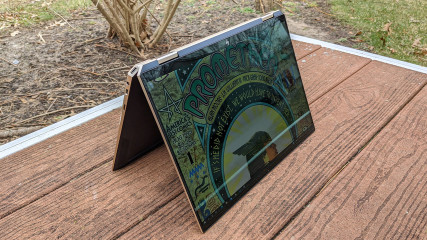

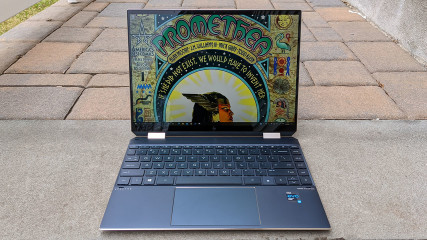









28 Comments - Add comment